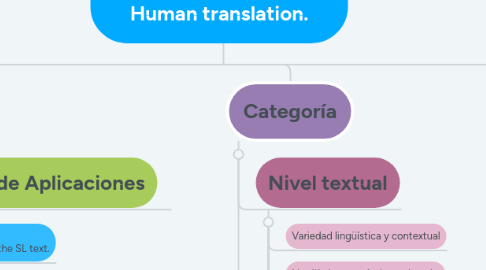
1. Categoría
1.1. Nivel textual
1.1.1. Variedad lingüística y contextual
1.1.2. Lingüística, semántica y sintaxis.
1.1.3. Morfologia, sintaxis.
1.1.4. Contexto, reglas.
1.1.5. Technical texts, legal and general texts.
1.1.6. Literatura,traducción.
1.1.7. Qualitative:Automatic Translation
1.1.8. Quality of MT, passive voice, mode of the verb, verbs tense.
1.1.9. Vocabulary and grammar.
1.1.10. Carácter morfológico, sintáctico, semántico.
1.2. Basados en teórias
1.2.1. Evaluation of MT
1.2.2. Apps, TA
1.2.3. Erros en TA.
1.2.4. Inclusion criteria, exclausion criteria
1.2.5. Translation technologies and translation theories.
1.2.6. Theoretical field and the field of application.
1.2.7. Context and Competence.
2. Contexto y población
2.1. Cuantitativa
2.1.1. 109 third-year Chinese English
2.1.2. Se realiza en 11 artículos.
2.1.3. Two main groups that are machine translation.
2.1.4. 171 Korean college students (120 male and 51 female; ages 19-21
2.1.5. 53 french articles
2.1.6. To analyze using a chosen Swedish text.
2.1.7. No especifica datos concretos, pero se divide en tres grupos.
2.2. Universidades
2.2.1. Se realiza en la Abu Dhabi.
2.2.2. Universidad de Granada
2.2.3. Universidad de Barcelona
2.2.4. Universidad de Alcalá
2.2.5. Universidad UAE
2.2.6. Universidade de Aliacante
2.2.7. Department of Translation Studies in Istanbul University
2.2.8. Universidad de Chile
2.3. País/ciudad.
2.3.1. Companias rusas.
2.3.2. Oklahoma
3. Resultados
3.1. Cualitativos
3.1.1. Negativo
3.1.1.1. Its positive impact across multiple application.
3.1.1.2. Teaching tranlation need for new directions for translate.
3.1.1.3. Los mayores errores que se producen en el sistema de TA que afecta el contextodel texto.
3.1.1.4. En obras literarios LA TA están alejados de obtener una traducción de buena calidad
3.1.1.5. El programa de TA comete errores.
3.1.1.6. It´s demonstrate that SWT have been mainly used for the disambiguation task in MT
3.1.2. Positivo
3.1.2.1. Automatic translation facilities on the Internet.
3.1.2.2. La TA favorece la comunicación frente a la traducción humana.
3.1.2.3. That translation is more important today than any period in human history.
3.1.2.3.1. Machine translation is still questionable.
3.1.2.4. El texto considerada c como una reinterpretación libre y creativa.
3.1.3. Imparcial
3.1.3.1. The machine, is in the same position as a foreign language learner who looks up words in a dictionary
3.1.3.2. Students’ adoption of MT and factors that might be influenced by using MT.
3.1.3.3. Teachers they become proficient in using translation apps.
3.2. Cuantitativos.
3.2.1. Solo tres frases de las quince que hay en total no han necesitado ninguna corrección
3.2.2. Most students are already familiar with using MT for L2 writing.
3.2.3. 40% of dissertations can seize the correlation between the theory and practice,60%) of them cannot bridge the gap.
3.2.4. Cinco análisis de TA en espacios web son confiables.
4. Línea de Inv.
4.1. Traducciones sin contexto.
4.2. Disadvantage of existing MT.
4.3. Errores presentes en la TA .
4.4. Relationship between translation theories and TA
4.5. Morphologically languages for supporting MT.
4.6. Behavioral adoption of MT in translating.
4.7. TA con fines de asimilación.
4.8. Investigar las pros y contras de un TA.
4.9. The translation mistakes found in the TT
4.10. Effectiveness of MT as perceived by teachers and students.
5. Método
5.1. Análisis de Aplicaciones
5.1.1. Analyze and understand the SL text.
5.1.2. Traducción interlingual
5.1.3. Aplicar modelos diferenciados de análisis
5.1.4. Translation tools into three groups: a) CAT tools, b) dictionaries and c) grammars
5.1.5. Evaluacion de apliaciones
5.1.6. Machine translation to English- Swedish Magazine.
5.1.7. Traducción automática.
5.1.8. Program at the SC19
5.1.9. Apps translation
5.1.10. Aplicate MT system
5.2. Cualitativa
5.2.1. Análisis de textos.
5.2.1.1. Quality organisations introduced controls on the vocabulary.
5.2.1.2. Research Text descriptive.
5.2.1.3. Ejercicios de tipología de errores ampliada.
5.2.1.4. Análisis de frases.
5.2.1.5. Método morfológico y sintáctico.
5.2.1.6. MT system and basic paragraph structure, and characteristics of the assigned genre.
5.3. Cuantitativa
5.3.1. Evaluacion con Alumnos.
5.3.1.1. Conduct this systematic survey 80.
5.3.1.2. Questionnaire.
5.3.1.3. Recognized on two types of classroom activities.
5.3.1.4. Observation method, analysis, statistical method, generalization method.
